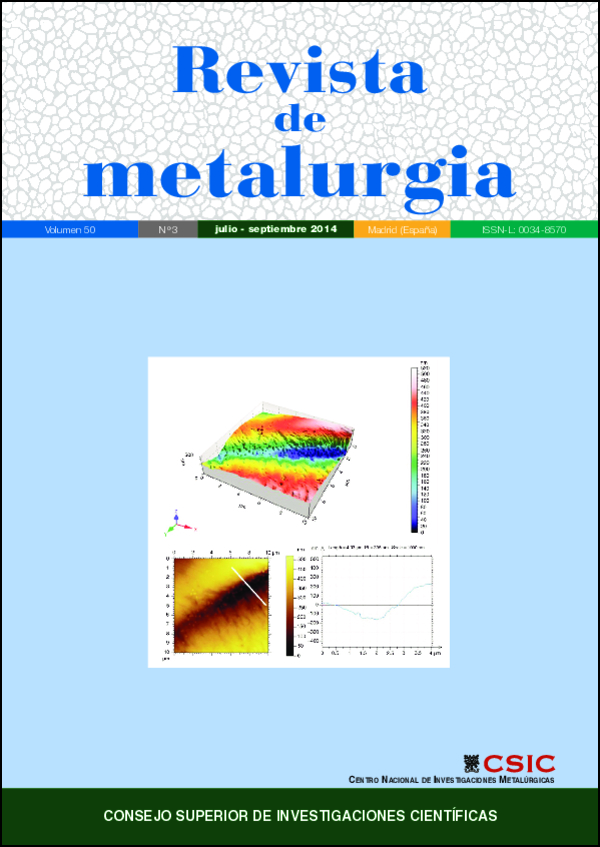Influence of the austenite-martensite transformation in the dimensional stability of a new tool steel alloyed with niobium (0.08% wt.) and vanadium (0.12% wt.)
DOI:
https://doi.org/10.3989/revmetalm.018Keywords:
Austenite, Dimensional stability, Martensite, Niobium, Phase transformations, Tool steel, VanadiumAbstract
Austenite-martensite transformation influence on the dimensional stability of a new experimental tool steel alloyed with niobium (0.08% wt.) and vanadium (0.12% wt.) has been studied. The dimensional stability of this new steel was compared with the dimensional stability of commercial steel, after and before two thermal treatments, T1 (860 °C) and T2 (900 °C). The thermal treatments consisted on heating and cooling, at 1 atmosphere of pressure, in N2 atmosphere furnace, fol lowing by heating in a conventional furnace at 180 °C during 1 hour. Initially, the experimental steel composition and Ac1 and Ac3 transformation temperatures were determined by glow-discharge luminescence (GDL) and dilatometric tests, respectively, in order to select the austenization temperatures of T1 and T2 treatments. After hardness measurement, the microstructure of both steels was characterized by X-Ray Diffraction (XRD) and optical metallography, before and after of T1 and T2 thermal treatments. Finally, longitudinal and angular dimensional stability analyses were realized for both commercial and experimental steels. After a contrastive hypothesis analysis, the results showed that the longitudinal relative variation of the experimental steel calculated was around 0.2% and the angular relative variation was not significant
Downloads
References
Arimoto, K., Yamanaka, S., Narazaki, M., Funatani, K. (2009). Explanation of the origin of quench distortion and residual stress in specimens using computer simulation. Int. J. Microstruct. Mater. Prop. 4 (2), 168–186.
Baker, T.N. (2009). Processes, microstructure and properties of vanadium microalloyed steels. Mater. Sci. Tech. 25 (9), 1083–1107. http://dx.doi.org/10.1179/174328409X453253
Bhadeshia, H.K.D.H. (2002). Materials Factor. Handbook of residual stress and deformation of steel, Ed. ASM International, Materials Park, USA, pp. 3–10.
Canale, L.C., Totten, G.E. (2005). Overview of distortion and residual stress due to quench processing. Part I: factors affecting quench distortion. Int. J. Mater. Prod. Tec. 24 (1–4), 4–52. http://dx.doi.org/10.1504/IJMPT.2005.007941
Fernández, B.J., Damborenea, J., Ruiz, J. (2002). Effect of hightemperature surface hardening of metallic materials on their dimensional stability. Mater. Design. 23 (4), 377–383. http://dx.doi.org/10.1016/S0261-3069(02)00002-X
Fossaert, C., Rees, G., Maurickx, T., Bhadeshia, H.K.D.H. (1995). The effect of niobium on the hardenability of microa lloyed austenite. Metall. Mater. Trans. A 26 (1), 21–30. http://dx.doi.org/10.1007/BF02669791
García-Mateo, C., Sourmail, T., Caballero, F.G., Capdevila, C., García de Andrés, C. (2005). New approach for the bainite start temperature calculation in steels. Mater. Sci. Tech. 21 (8), 934–940. http://dx.doi.org/10.1179/174328405X51622
Gladman T. (1966). On the Theory of the effect of precipitate particles on grain growth in metals. P. Roy. Soc. Lond. A Mat. Phy. 294, 298–309. http://dx.doi.org/10.1098/rspa.1966.0208
Mangonon, P.L. (2001). Procesos térmicos: tratamientos térmicos, Ciencia de Materiales: Selección y Dise-o, Ed. Pearson Educación, Méjico D.F, México, pp. 316–388.
Mendenhall, W., Sincich, T. (1997). Probabilidad y Estadística para Ingeniería y Ciencias, Ed. Prentice Hall, México D.F., México. Montgomery, D.C., Runger, G.C. (2003). Applied statistics and probability for engineers, Ed. John Wiley and Sons, Nueva York, USA.
Nallathambi, A.K., Kaymak, Y., Specht, E., Bertram, A. (2010). Sensitivity of material properties on distortion and residual stresses during metal quenching processes. J. Mater. Process. Tech. 210 (2), 204–211. http://dx.doi.org/10.1016/j.jmatprotec.2009.09.001
Norma UNE-EN-ISO-6508 (2007). Aceros Metálicos: ensayos de dureza Rockwell, Ed. AENOR, Madrid, Espa-a.
Paquin, R.A. (1990). Dimensional Stability: an overview, Proceedings of. SPIE, Society of Photo-optical Instrumentation Engineers, Vol. 1335, Bellingham, USA, pp. 2–19. http://dx.doi.org/10.1117/12.22870
Qiu, H., Qi, J., Yin, F., Hiraoka, K. (2009). Determination of parameters for fitting the dilatation curve of austenite– martensite transformation in Cr–Ni steels. ISIJ Int. 49 (1), 146–148. http://dx.doi.org/10.2355/isijinternational.49.146
Rees, G.I., Perdrix, J., Maurickx, T., Bhadeshia, H.K.D.H. (1995). The effect of niobium in solid solution on the transformation kinetics of bainite. Mat. Sci. Eng. A-Struct. 194 (2), 179–186. http://dx.doi.org/10.1016/0921-5093(94)09673-2
Rietveld, H.M. (1969). A profile refinement method for nuclear and magnetic structures. J. Appl. Crystallogr. 2 (2), 65–71. http://dx.doi.org/10.1107/S0021889869006558
San Martín, D., Caballero, F.G., Capdevila, C., García-de- Andrés, C. (2006). Estudio y modelización de la influencia de las partículas de segunda fase sobre el crecimiento de grano austenítico en un acero microaleado con niobio. Rev. Metal. 42 (2), 128–137.
Santofimia, M.J. (2006). La transformación bainítica sin formación de carburos en aceros, Tesis Doctoral, Departamento de Física de Materiales, Universidad Complutense (UCM), Madrid, Espa-a.
Skoog, D.A., Crouch, S.R., Holler, F.J. (2007). Principles of Instrumental Analysis, Ed. Thomson-Brooks/Cole, Belmont, USA. Steven, W., Haynes, A. G. (1956). The temperature of formation of martensite and bainite in low alloy steels. J. Iron Steel Inst. 183, 349–359.
Telher M. (2009). Modeling phase transformations and volume changes during cooling of case hardening steels, Tesis de Licenciatura, Department of Materials Science and Engineering, Royal Institute of Technology (KTH), Estocolmo, Suecia.
Yang, H.S, Bhadeshia, H.K.D.H. (2009). Austenite grain size and the martensite-start temperature. Scripta Mater. 60 (7), 493–495. http://dx.doi.org/10.1016/j.scriptamat.2008.11.043
Yao, X., Zhu, L., Li, V. (2004). Finite element analysis of residual stress and distortion in an eccentric ring induced by quenching, Proceedings of the 14th IFHTSE Congress, Vol. 25, Transactions of Materials and Heat Treatment, Beijing, China, pp. 746–751.
Published
How to Cite
Issue
Section
License
Copyright (c) 2014 Consejo Superior de Investigaciones Científicas (CSIC)

This work is licensed under a Creative Commons Attribution 4.0 International License.
© CSIC. Manuscripts published in both the printed and online versions of this Journal are the property of Consejo Superior de Investigaciones Científicas, and quoting this source is a requirement for any partial or full reproduction.All contents of this electronic edition, except where otherwise noted, are distributed under a “Creative Commons Attribution 4.0 International” (CC BY 4.0) License. You may read here the basic information and the legal text of the license. The indication of the CC BY 4.0 License must be expressly stated in this way when necessary.
Self-archiving in repositories, personal webpages or similar, of any version other than the published by the Editor, is not allowed.
















